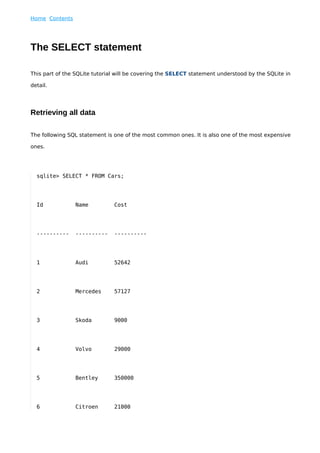
The select statement
- 1. Home Contents The SELECT statement This part of the SQLite tutorial will be covering the SELECT statement understood by the SQLite in detail. Retrieving all data The following SQL statement is one of the most common ones. It is also one of the most expensive ones. sqlite> SELECT * FROM Cars; Id Name Cost ---------- ---------- ---------- 1 Audi 52642 2 Mercedes 57127 3 Skoda 9000 4 Volvo 29000 5 Bentley 350000 6 Citroen 21000
- 2. 7 Hummer 41400 8 Volkswagen 21600 Here we retrieve all data from the Cars table. Selecting specific columns We can use the SELECT statement to retrieve specific columns. The column names follow the SELECT word. sqlite> SELECT Name, Cost FROM Cars; Name Cost ---------- ---------- Audi 52642 Mercedes 57127 Skoda 9000 Volvo 29000 Bentley 350000 Citroen 21000 Hummer 41400
- 3. Volkswagen 21600 We retrieve the name and the cost columns. The column names are separated by commas. Renaming column names We can rename the column names of the returned result set. For this, we use the AS clause. sqlite> SELECT Name, Cost AS Price FROM Cars; Name Price ---------- ---------- Audi 52642 Mercedes 57127 Skoda 9000 Volvo 29000 Bentley 350000 Citroen 21000 Hummer 41400 Volkswagen 21600 Say we wanted to name the column price rather than cost. With the above SQL statement, we have
- 4. accomplished this. Limiting data output As we mentioned above, retrieving all data is expensive when dealing with large amounts of data. We can use the LIMIT clause to limit the data amount returned by the statement. sqlite> SELECT * FROM Cars LIMIT 4; Id Name Cost ---------- ---------- ---------- 1 Audi 52642 2 Mercedes 57127 3 Skoda 9000 4 Volvo 29000 The LIMIT clause limits the number of rows returned to 4. The OFFSET clause following LIMIT specifies how many rows to skip at the beginning of the result set. sqlite> SELECT * FROM Cars LIMIT 4 OFFSET 2; Id Name Cost ---------- ---------- ----------
- 5. 3 Skoda 9000 4 Volvo 29000 5 Bentley 350000 6 Citroen 21000 Here we select all data from max four rows, and we begin with the third row. The OFFSET clause skips the first two rows. Orderig data We use the ORDER BY clause to sort the returned data set. The ORDER BY clause is followed by the column on which we do the sorting. The ASC keyword sorts the data in ascending order, the DESC in descending order. sqlite> SELECT Name, Cost FROM Cars ORDER BY Cost DESC; Name Cost ---------- ---------- Bentley 350000 Mercedes 57127 Audi 52642 Hummer 41400
- 6. Volvo 29000 Volkswagen 21600 Citroen 21000 Skoda 9000 In the above SQL statement, we select name, cost columns from the Cars table and sort it by the cost of the cars in descending order. So the most expensive cars come first. Selecting specific rows with the WHERE Clause In the following examples, we are going to use the Orders table. sqlite> SELECT * FROM Orders; Id OrderPrice Customer ---------- ---------- ---------- 1 1200 Williamson 2 200 Robertson 3 40 Robertson 4 1640 Smith 5 100 Robertson
- 7. 6 50 Williamson 7 150 Smith 8 250 Smith 9 840 Brown 10 440 Black 11 20 Brown Here we see all the data from the Orders table. Next, we want to select a specific row. sqlite> SELECT * FROM Orders WHERE id=6; Id OrderPrice Customer ---------- ---------- ---------- 6 50 Williamson The above SQL statement selects a row which has id 6. sqlite> SELECT * FROM Orders WHERE Customer="Smith"; Id OrderPrice Customer ---------- ---------- ----------
- 8. 4 1640 Smith 7 150 Smith 8 250 Smith The above SQL statement selects all orders from the Smith customer. We can use the LIKE keyword to look for a specific pattern in the data. sqlite> SELECT * FROM Orders WHERE Customer LIKE 'B%'; Id OrderPrice Customer ---------- ---------- ---------- 9 840 Brown 10 440 Black 11 20 Brown This SQL statemet selects all orders from customers whose names begin with B character. Removing duplicate items The DISTINCT keyword is used to select only unique items from the result set. sqlite> SELECT Customer FROM Orders Where Customer LIKE 'B%'; Customer
- 9. ---------- Brown Black Brown This time we have selected customers whose names begin with B character. We can see, that Brown is mentioned twice. To remove duplicates, we use the DISTINCT keyword. sqlite> SELECT DISTINCT Customer FROM Orders Where Customer LIKE 'B%'; Customer ---------- Black Brown This is the correct solution. Grouping data The GROUP BY clause is used to combine database records with identical values into a single record. It is often used with the aggregation functions. Say we wanted to find out, the sum of each customers' orders. sqlite> SELECT sum(OrderPrice) AS Total, Customer FROM Orders GROUP BY Customer;
- 10. Total Customer ---------- ---------- 440 Black 860 Brown 340 Robertson 2040 Smith 1250 Williamson We used the sum() keyword returns the total sum of a numeric column. The GROUP BY clause divides the total sum among the customers. So we can see, that Black has ordered items for 440 or Smith for 2040. We cannot use the WHERE clause when aggregate functions were used. We use the HAVING clause. sqlite> SELECT sum(OrderPrice) AS Total, Customer FROM Orders GROUP BY Customer HAVING sum(OrderPrice)>1000; Total Customer ---------- ---------- 2040 Smith 1250 Williamson
- 11. The above SQL statement selects customers whose total orders where greater than 1000 units. In this part of the SQLite tutorial, we mentioned the SQL SELECT statement in more detail.